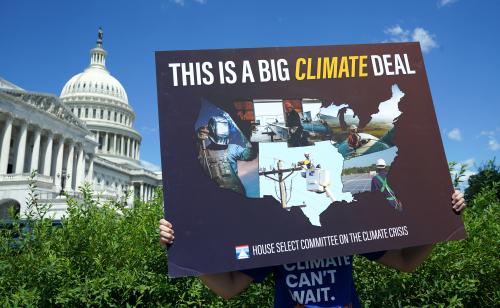Among its many provisions, the Inflation Reduction Act is the largest single piece of climate legislation ever passed in the United States. The incentives in the bill will affect the entire energy sector, from producers of raw materials to end-use consumers. In a new BPEA paper, John Bistline, Neil R. Mehrotra, and Catherine Wolfram sought to quantify the economic impacts of these provisions, finding that they would indeed reduce carbon emissions significantly but that they would also cost more than government projections. On this episode of the Brookings Podcast on Economic Activity, author Neil Mehrotra speaks with Sanjay Patnaik, director of Brookings’ Center on Regulation and Markets, about the findings in his paper and potential policy implications.
- Listen to the Brookings Podcast on Economic Activity on Apple, Spotify, Google, or wherever you like to get podcasts.
- Learn about other Brookings podcasts from the Brookings Podcast Network.
- Sign up for the podcasts newsletter for occasional updates on featured episodes and new shows.
- Send feedback email to [email protected].
TRANSCRIPT
[music]
STOCK: I’m Jim Stock, coeditor of the Brookings Papers on Economic Activity, the semiannual academic conference and journal that pairs rigorous research with real time policy analysis to address the most urgent economic challenges of the day. On behalf of my coeditor Jan Eberly of Northwestern University, as well as the rest of the Brookings team, I’d like to thank you for joining us for this episode of the Brookings Podcast on Economic Activity. Here we share conversations with leading economists on the research they do and how it will affect economic policy.
On this episode, you’ll hear from Neil Mehrotra on his new paper, “Economic Implications of the Climate Provisions of the Inflation Reduction Act,” which he coauthored with John Bistline of the Electric Power Research Institute and Catherine Wolfram of Harvard and UC Berkeley. Neil will be interviewed by Sanjay Patnaik of the Center on Regulation and Markets.
The Inflation Reduction Act is the largest single piece of climate legislation ever passed in the United States. In the past, climate policies in the U.S. have contemplated both carrots and sticks. The carrots have included investment tax credits for building clean energy facilities or production tax credits for producing low carbon fuels or electricity. The contemplated sticks included a carbon tax or a cap-and-trade system. Perhaps not surprisingly, the carrots won out historically in the legislative process. The Inflation Reduction Act, or IRA, goes all in on the carrots with large and lasting tax credits and subsidies for clean electricity from wind, solar, nuclear, geothermal, and storage with tax credits for electric vehicles and much more.
In their paper Bistline, Mehrotra, and Wolfram estimate the total amount of these credits, their macroeconomic impact, and their impact on energy markets and EV adoption. From an emissions perspective, they, like others, find that the IRA provisions spur emission reductions in a cost beneficial way. The marginal costs of reductions are far less than the social cost of carbon. Like the U.S. Energy Information Administration, they estimate that the IRA will reduce CO2 emissions relative to 2005 by about 7 percentage points to somewhere around a 40% reduction. But I don’t want to give away too much, and I hope you’ll enjoy listening to more on this important topic as much as I do. So, now I’ll hand it over to Sanjay and Neil for the conversation that they recorded on April 7th.
PATNAIK: Thank you so much, Jim. I’m Sanjay Patnaik. I’m the director of the Center on Regulation and Markets at Brookings. Joining me today is Neil Mehrotra, assistant vice president and policy advisor at the Federal Reserve Bank of Minneapolis. We will be discussing his new paper, “Economic Implications of the Climate Provisions of the Inflation Reduction Act,” the IRA, coauthored with John Bistline and Catherine Wolfram, which was presented at the Spring 2023 Brookings Papers on Economic Activity Conference in Washington, D.C. Thank you so much, Neil, for joining us today here.
MEHROTRA: Hi, Sanjay. It’s good to be with you. Thanks for having me.
PATNAIK: Of course. I think most of our listeners are aware of the importance of climate change as a political issue. But before we dive into your findings, I think we should provide a little context. Can you please tell us about the climate provisions in the Inflation Reduction Act and what their goals are?
MEHROTRA: The climate provisions in the Inflation Reduction Act are a set of tax incentives for both businesses and individuals to move towards clean energy. So, on the business side, there are tax credits that incentivize the investment in solar, wind, and other non-carbon sources of power generation. And on the household side, there are incentives to buy electric vehicles; to invest in other residential improvements that are clean energy like heat pumps and rooftop solar panels; and there are also provisions in the law that are trying to incentivize the use of newer technologies and emerging technologies. So, things like carbon capture and utilization, things like clean fuels, particularly green hydrogen.
So, there’s a lot of different pieces in the Inflation Reduction Act, all geared towards both subsidizing clean energy and encouraging firms and households to invest in clean energy, but to also create a manufacturing base for building those technologies here in the U.S.
PATNAIK: Wonderful. This is a very good overview, and as the title of your paper suggests, you were focused on the economics of the IRA. So, let’s start a little bit with this. Can you tell us about your main findings?
MEHROTRA: Sure. So, we try in this paper to tackle three big questions, like, what are the implications for the Inflation Reduction Act for energy markets? What are the macroeconomic implications of these provisions in the Inflation Reduction Act? And how should we think about the economic merits of the subsidies approach that the act takes relative to a carbon tax, which has been historically what economists have advocated for in tackling climate change?
And what we find here is that the Inflation Reduction Act will have pretty large effects on energy markets. There will be a 50% increase under our projections and the amount of new investment in renewable and zero carbon power generation. There will be something like a 6 to 10 percentage point reduction in CO2 emissions over the next decade. And this act will have large effects on electricity prices. So, wholesale electricity prices, which are the prices paid by businesses and industries, those could fall quite substantially. And there’ll be some further reduction in electricity prices that are passed through to consumers. So, on the energy market side, you have some fairly large impacts.
On the macroeconomic side, we make the point that the climate provisions in the Inflation Reduction Act are a type of supply side policy. By lowering the price of electricity, they’re boosting economic potential, they’re boosting wages and labor productivity in the long term. But in the short term, they’re also boosting demand because there’s more demand for investing in clean energy capital. And that can raise interest rates in the short run and crowd out other sources of demand in the short run.
We try and quantify these effects through a macro model that the Federal Reserve uses called the Federal Reserve’s U.S. Model. And we find that these transition effects, sort of the demand effects in the short run are relatively small. And so, there is some increase in interest rates in the short run, but those aren’t particularly large.
Now, if we think about it from the other side, the macroeconomic effects of the Inflation Reduction Act, that the climate provisions are small, but the macroeconomic environment is pretty first order for how effective the Inflation Reduction Act will be. So, if we’re entering a period where interest rates are higher, where the cost of different raw materials is much higher than they were prior to the pandemic, then those could have negative effects in terms of the amount of investment that the Inflation Reduction Act ultimately delivers. So, those are the big findings for energy markets and for the macroeconomic effects.
On the question of subsidies versus a carbon tax, our paper makes the point that in general, through the lens of a model, a carbon tax is the preferred instrument to use to try and address climate change. But there is a role for subsidies if we think that there are important externalities in the process of building clean energy capital. When you build that capital, if you learn about making clean energy capital more cheaply, then that “learning by doing” externality that we call it, that can be an important reason for taking a subsidies approach versus a carbon tax approach.
PATNAIK: Very interesting and really important work. Let me elaborate a little bit on there. So, can you also talk a bit about what the climate provisions of the IRA are expected to cost? And you touched a bit upon it, but can you talk about what the impacts on carbon emissions would be, kind of like the trajectory? Any other effects on the overall economy that you might not have mentioned yet?
MEHROTRA: Sure. So, one of the important findings in our paper is that the fiscal expenditures associated with the Inflation Reduction Act are likely to be somewhat larger than were originally projected by the Congressional Budget Office and the Joint Committee on Taxation. These are the two agencies that try and forecast how much the legislation will cost over a 10-year window. And our finding is that the 10-year cost would be closer to around $900 billion instead of the $400 billion that was projected by the CBO and JCT. And there’s many reasons that we’re getting a higher fiscal cost. The reason that the legislation will cost more is that there’s more uptake, there’s more increased investment in clean energy capital, which is part of the goal of the legislation.
In terms of its effect on the trajectory of emissions, we expect that at the end of 2030 U.S. emissions will be something like 35% below their 2005 level, and that is getting close to what our commitment is under the Paris Agreement, which we were trying to get to 50% by 2030. So, the climate provisions and the Inflation Reduction Act move us materially closer to attaining that emissions target.
PATNAIK: Great, that’s a very important step. And I want to drill in a bit more on the issue of the cost. So, your paper uses a model that suggests that the climate provisions will cost much more than anticipated and estimated by the CBO, the Congressional Budget Office, and the Joint Committee on Taxation. And so, this may require a bit of a technical answer, but I’m curious to know how your model and those at the CBO and JCT differ. And why do you think the estimates diverge so significantly?
MEHROTRA: I think there’s a great deal of uncertainty when it comes to any piece of legislation how you score that legislation, because you have to make predictions about the future, which are always hard. And it’s particularly complicated with a piece of legislation that’s as novel as the Inflation Reduction Act.
The answer is that we have an energy industry model that we use to model how businesses and individuals, how they respond to the various tax incentives in the Inflation Reduction Act. And what we see is relatively high uptake, particularly for electric vehicles. So, one of the biggest differences between our fiscal cost over 10 years and that of the CBO/JCT, is we find substantially higher expenditures on electric vehicles. So, over the 10-year window, the CBO/JCT projected about $14 billion in electric vehicle tax credits. Our model sees something closer to $400 billion, so that’s a pretty big difference.
We also see a fairly big difference in how much carbon capture and sequestration those tax credits will be utilized. The CBO/JCT saw only about $3 billion worth of tax subsidies for that program. We see something closer to $100 billion. So, those are sort of the two big differences that account for the bulk of the difference between our projection and the CBO/JCT.
But I think the thing to emphasize here is that there’s just a great deal of uncertainty. There’s a great deal of uncertainty about how the underlying technologies will progress. There’s uncertainty about how changes in the macroeconomic environment can affect the amount of investment that ultimately takes place. There’s uncertainty about whether the various requirements in the legislation–so, in order for a vehicle to be eligible for a tax credit, it has to meet certain requirements when it comes to the sourcing of their batteries and the assembly of the batteries in electric vehicles. And there’s uncertainty about whether automakers will be able to meet the timelines that are in the legislation.
So, we show in the paper that we have a baseline forecast, but we also have a more pessimistic and a more optimistic scenario. The more pessimistic scenario has a fiscal cost that’s actually less than the CBO/JCT estimate, and the more optimistic scenario has a higher cost in that there will be more uptake of these tax credits. So, one of the things that comes out of our paper is that, yes, there’s likely to be a somewhat higher fiscal cost, but there’s a great deal of uncertainty associated with it. And different modeling teams and different assumptions can really affect what those projections look like.
PATNAIK: This is very helpful. And just to clarify, I assume that the reason that we can have this divergence in uptake of technologies and tax credits, for instance, is because there is no total cap of how many people can use these tax credits. Is that correct?
MEHROTRA: Exactly. So, the way that the legislation is written is that these tax credits are uncapped. So, that means that there’s no overall budget assigned to those tax credits. So, if more firms go out and build solar power plants and wind farms, then they’ll be eligible for the tax credits and the fiscal expenditure will go up. Similar with electric vehicles. If more people want to buy electric vehicles, if more vehicles qualify for the tax credit, then the expenditure associated with that provision will be higher.
The other thing to note about these tax credits, at least on the power generation side, is that they don’t expire after 10 years. They only expire once a certain threshold of emissions reduction is reached. And in our projections that emissions reduction is not reached in the first 10 years. So, we still have tax credits for solar, wind, and other clean energy power generation being taken up outside the 10-year budget window.
PATNAIK: That’s actually very interesting and shows how many moving parts we have here, like how many unknowns, as you pointed out, and uncertainties in terms of uptake and technologies. I want to pivot a little bit to a topic that is obviously it’s part of the name of the IRA, which is inflation. Inflation is top of mind for economic policymakers and many Americans right now. And the bill itself was intended to reduce inflation, as we know, in the name. So, how do you see the IRA and these climate provisions, especially affecting inflation?
MEHROTRA: The main way that the climate provisions of IRA will affect inflation is through the price of electricity. What we see is that through our modeling that the climate provisions have large effects on electricity investment and reduces the wholesale price of electricity. And that reduction in the wholesale price of electricity does eventually pass through to consumers. So, over the first 10 years, we see something like a 2 to 3 percentage point decline in consumer electricity prices. Now, that’s relatively small, but that does have a direct effect on inflation. So, households spend something like 2 or 3% of their budget on electricity. So, lower electricity prices benefits them directly.
The modeling that we have suggests that the overall effect on inflation is mostly coming through this effect on the price of electricity and that over and past the first 10 years you will have a small decline in inflation, primarily coming from those lower electricity prices.
Now, there are other provisions in the Inflation Reduction Act that will also affect inflation that were not the focus of our study. We weren’t looking at the overall effect on the deficit. We weren’t looking at the provisions with respect to prescription drugs that can also lower prices. So, there are other things in the bill that can affect inflation.
PATNAIK: Great. Thank you. And I think the finding about electricity prices is really very powerful and can show the potential impact the IRA can have.
MEHROTRA: One other thing to add to this is that to the extent that the shift to electricity lowers demand for fossil fuels like crude oil, gasoline, natural gas, those can also have substantial effects on overall inflation through lower prices for those commodities. And that’s, again, not something that was directly modeled in our paper, but it’s something to keep in mind when we try and think through the various ways that the Inflation Reduction Act will affect prices that consumers pay.
PATNAIK: That’s a very great point. Thank you. I also want to turn a little bit to kind of like the way forward and the future, right. You note in your paper that the IRA gets the U.S. significantly closer to our emissions reductions goals. However, even assuming a best case outcome, there will still be work to do. Looking forward, how do you hope your paper will inform future climate related policy?
MEHROTRA: Our model is just one model looking at what effects the climate provisions may have over the first decade. There is considerable uncertainty about how much uptake there will be of these various tax credits. And to the extent that policymakers make decisions that facilitate the construction of clean power generation and that facilitate the construction of the battery manufacturing plants that are needed in order to build the electric vehicles in the U.S., those decisions will help make IRA more successful and will also drive down emissions at a faster rate.
So, one of the things that has been talked about is finding ways to speed up the permitting associated with clean power generation and finding ways to increase the transmission capacity so that we can take wind power generated in the Midwest and move that power to other parts of the country, that we can take solar power generated in the Southwest and move that to other parts of the country.
And this will require different decisions by the federal government, by state and local governments, by public utilities commissions. They will all play a role in determining ultimately how much investment takes place and the ultimate pace of emissions reductions.
There’s probably no one policy that will result in a huge change in how much investment takes place. But there are lots of little steps that policymakers can take at all levels of government to make these provisions more efficacious.
PATNAIK: And I think your point on permitting is really well taken because we need to implement that and we need to build the infrastructure and that requires the permits. With this, we’re actually at the end of today’s session. Thank you so much, Neil, for joining me today for this discussion.
[music]
And to our listeners, if you would like to read their full paper, please visit Brookings dot edu slash BPEA and click the Spring 2023 button. Thank you very much.
STOCK: Once again, I’m Jim Stock, Harold Hitchings Burbank Professor of Political Economy at Harvard and coeditor of Brookings Papers on Economic Activity with Jan Eberly of Northwestern University, and this has been the Brookings Podcast on Economic Activity. Thanks to our colleagues for this great conversation and be sure to subscribe to hear more discussions with BPEA authors.
The Brookings Podcast on Economic Activity is produced by the Brookings Podcast Network. Learn more about this and our other podcasts at Brookings dot edu slash podcasts. Send feedback to podcasts at Brookings dot edu, and find out more about the Brookings Papers on Economic Activity on the website, Brookings dot edu slash BPEA.
Thanks to the team that makes this podcast possible, including Kuwilileni Hauwanga, supervising producer; Fred Dews, producer; and Gastón Reboredo, audio engineer; with support from Shannon Meraw and Chris Miller in Economic Studies at Brookings. Show art was designed by Katie Merris of Brookings, and promotional support comes from our colleagues in Brookings Communications and Economic Studies.
The Brookings Institution is committed to quality, independence, and impact.
We are supported by a diverse array of funders. In line with our values and policies, each Brookings publication represents the sole views of its author(s).








Commentary
PodcastHow much will the climate provisions in the IRA cost, and what will they achieve?
April 27, 2023
Listen on
Brookings Podcast on Economic Activity